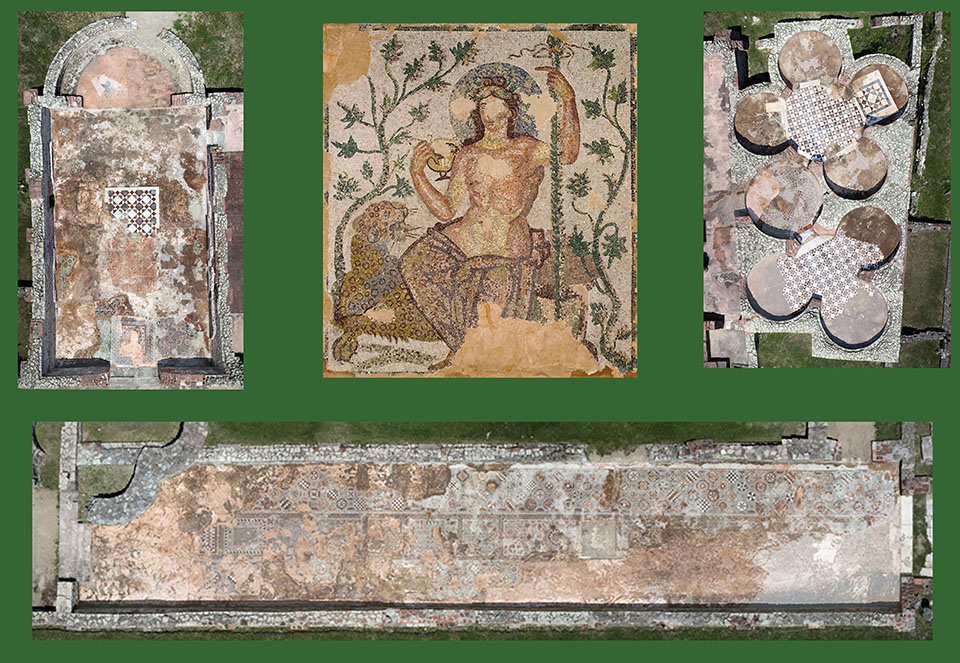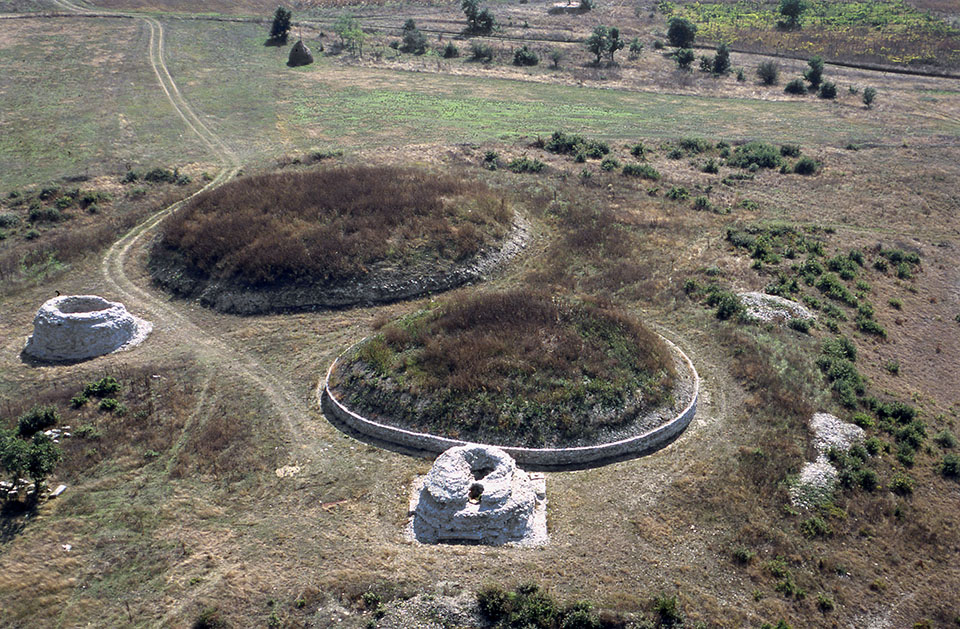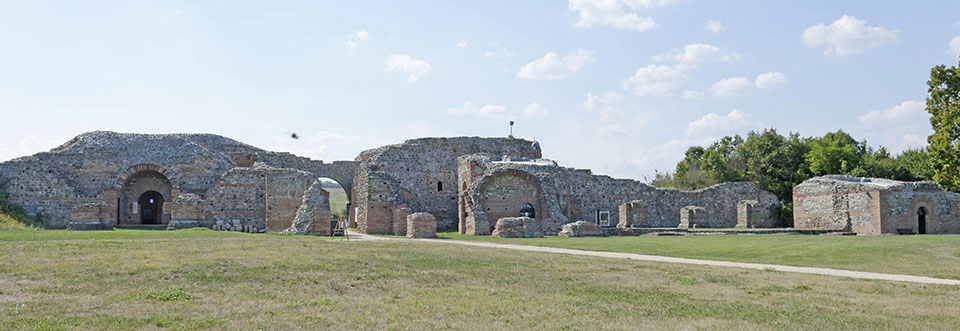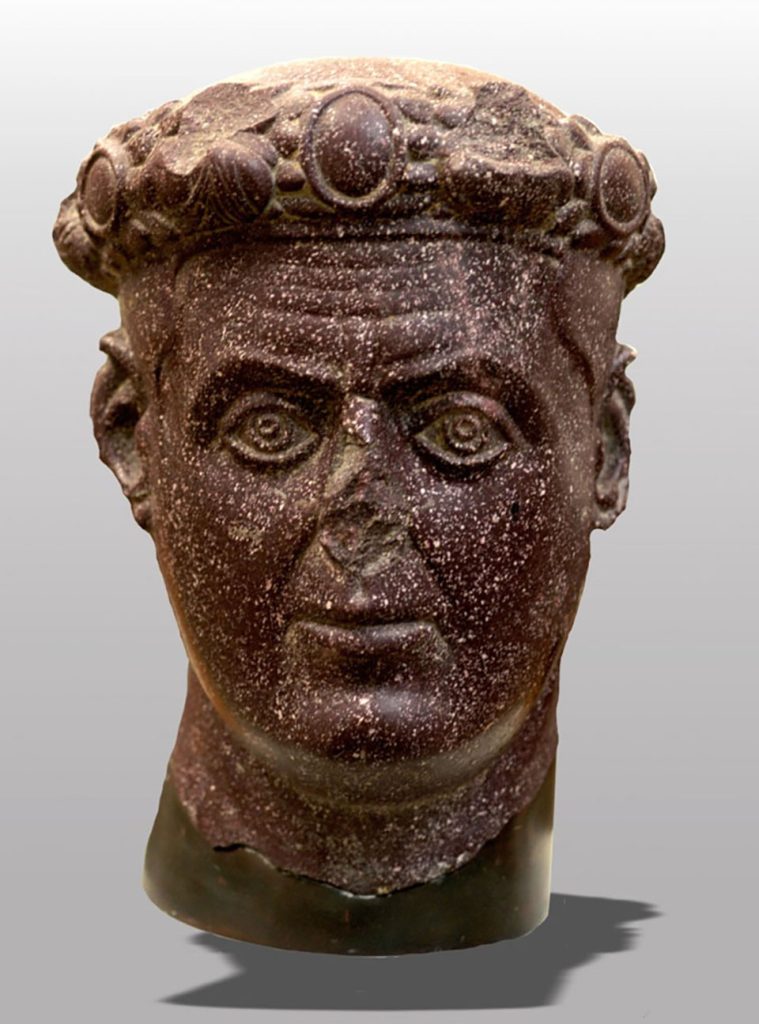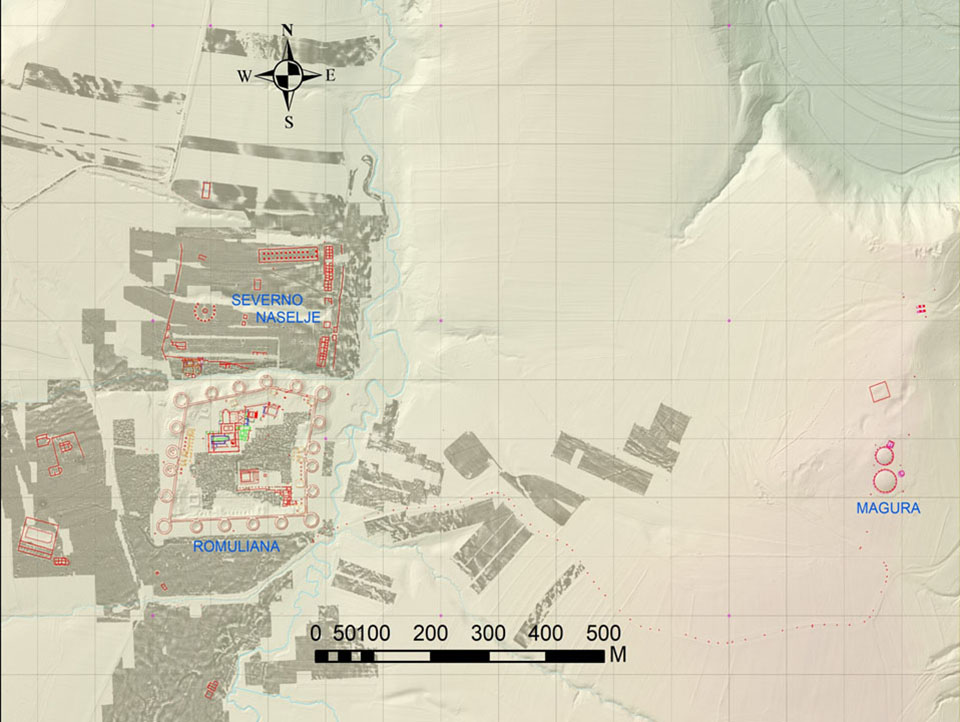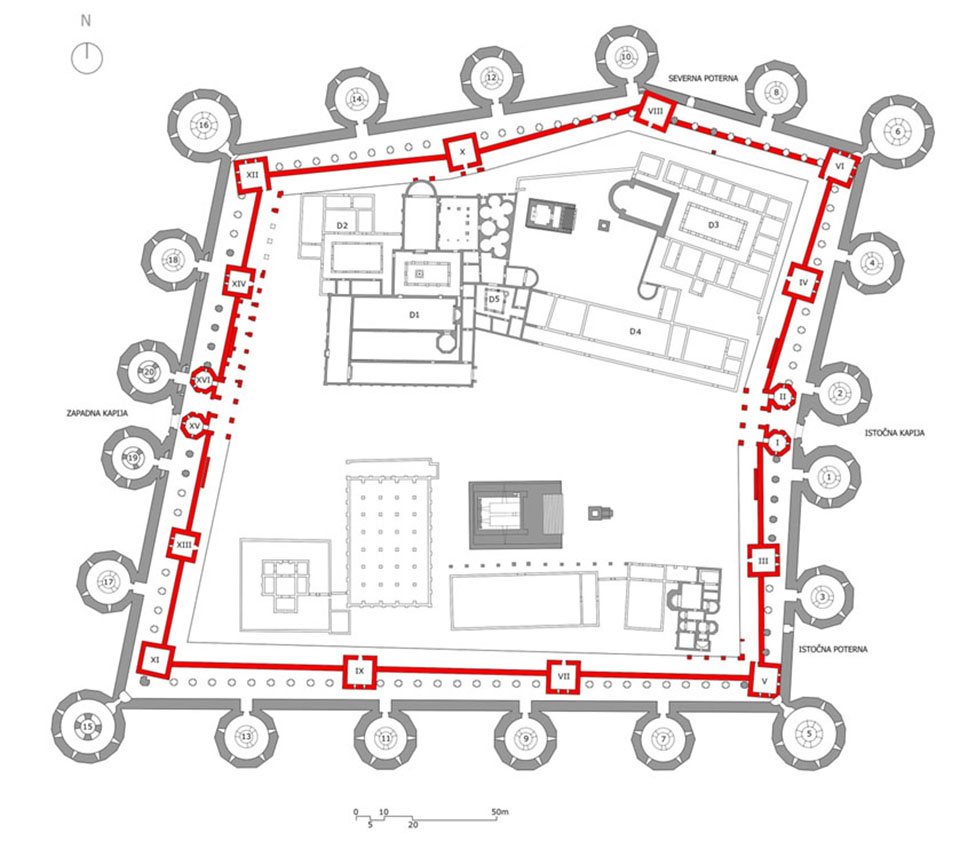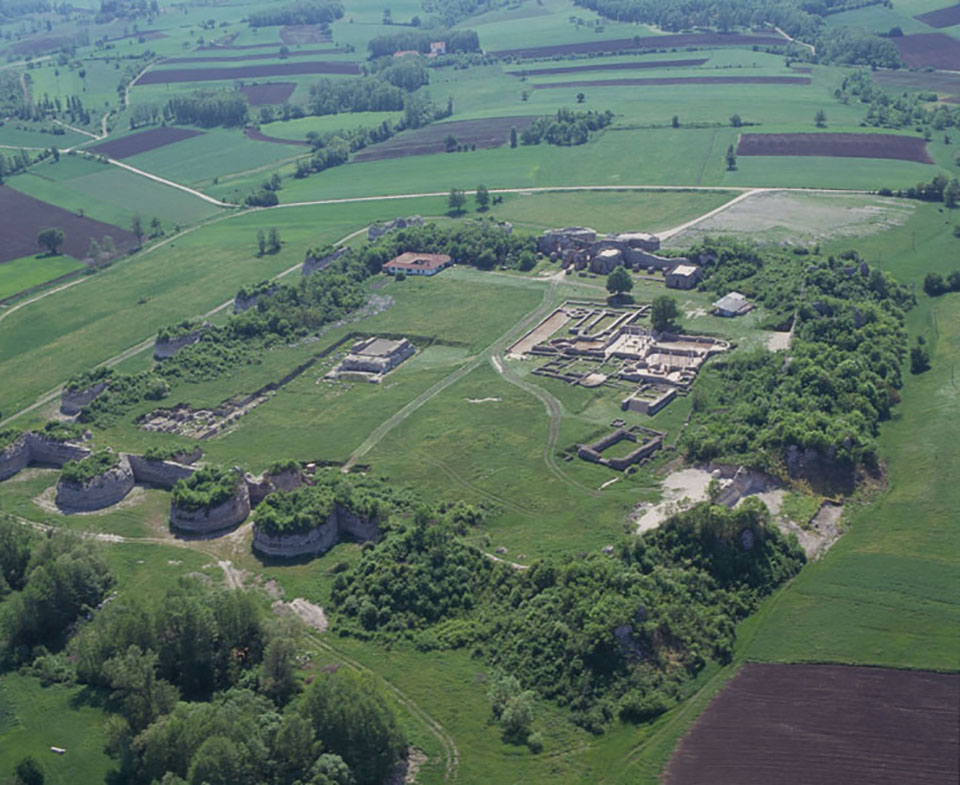
FELIX ROMULIANA – GAMZIGRAD
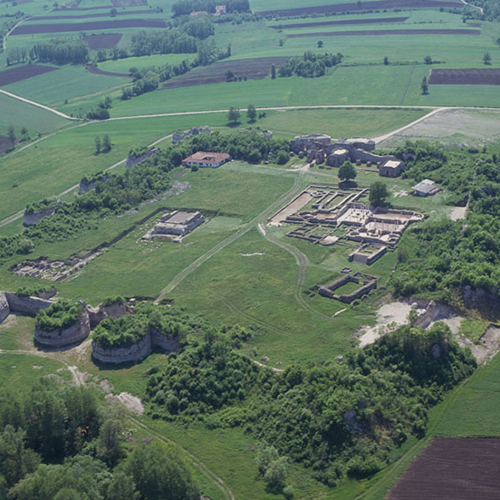
Project name: Felix Romuliana – Gamzigrad
Research leader: Dr. Stefan Pop-Lazić, Dr. Christoph Rummel
Collaborators: Dr. Bojan Popović, Dr. Maja Živić
Institutions involved in the research process:
Institute of Archeology, Belgrade;
Zaječar National Museum,
Republic Institute for the Protection of Cultural Monuments,
Roman-Germanic Commission of the German Archaeological Institute
The fortified palace of Emperor Galerius represents the best preserved work of Roman architecture in the whole territory of Serbia. In 2007, this site was inscribed on the UNESCO World Heritage List. Over many years of research, almost the entire internal structure of the residential complex built at the beginning of the 4th century was uncovered. In addition to the palace itself, the complex comprises temples, a granary, thermae and ancillary buildings. Monumental gates, towers and ramparts are preserved up to a height of over six metres. Some parts of the site feature architecture from later periods – the early Byzantine and mediaeval. The investigations conducted over the last few years have been focused on the immediate surroundings of the fortified complex. Using the geophysical method, a number of new buildings have been discovered, as well as an entire settlement complex in the vicinity.
The specific geographical position in a valley, protected by the surrounding hills, determined the character of the tetrarchy memorial complex, which consists of two fortification systems, buildings within the fortifications and sacral architecture on Magura Hill. In the period of Late Antiquity, from the second half of the 4th century to the end of the 6th century, as well as during the 10th-11th centuries, the life of several different settlements took place above the tetrarchy complex. The name Romuliana/Romulianum, recorded by ancient writers as the place where the Roman emperor Gaius Valerius Galerius Maximianus was born and was buried, and which he named after his mother Romula, is attested by the find of an archivolt with the inscription “Felix Romuliana”.
The first excavations of Gamzigrad were started in 1953 under the leadership of Prof. Đorđe Mano-Zisi, on the initiative of the National Museum in Zaječar, in cooperation with the Archaeological Institute SAN. In the first years, the research focus was on the area of the palace (D1) in the north-western part of the complex. At the very beginning of the research, Prof. Mano-Zisi saw the importance of mosaics for understanding the purpose of the Gamzigrad architecture. By analyzing the artistic features of the mosaics and the techniques used in the decoration of architectural plastic, he concluded that the decoration of the palace corresponds to the time of the tetrarchy, as well as that Gamzigrad was probably the seat of some important person. As only a small part of the interior of the residential complex had been explored at that time, Gamzigrad was viewed as a castrum, a state asset, a fortified villa or even a city.
A key change in the research concept occurred with the arrival of Prof. Dragoslav Srejović as the head of the research project in 1970. Excavations of buildings inside the complex during the 1970s were concentrated on the Small and Great Temples. Prof. Srejović connected the construction of the Small Temple with the cult of the goddess Cybele, in which the deified Romula was worshipped. Based on the discovery of parts of an imperial sculpture and a sculpture of Hercules near the Great Temple, as well as on the basis of the features of the structure itself, he assumed that it united two sanctuaries; one dedicated to a chthonic deity and the other dedicated to Hercules, and the emperor identified with him.
One of the key findings of the tetrarchy period in Gamzigrad is certainly the “Felix Romuliana” inscription discovered in 1983 in a building with a cruciform ground plan in the south-western part of the palatial complex. This discovery confirmed the opinion that the site of Gamzigrad can be identified with the place “Romulianum/Romuliana”.
The older rampart system covers an area of 3.6 ha. The fortification has an irregular polygonal base, with two octagonal towers on the eastern and western gates, completely protruding into the field in relation to the rampart. At the corners, and between them, the quadrangular towers protrude half way in relation to the direction of the ramparts.
The younger fortification system consists of 20 polygonal towers, the largest of which are the ones at the corners, which have a sixteen-sided outer base. Two twelve-sided towers each protect the eastern and western gates, while two ten-sided towers are arranged in the centre of the northern and southern ramparts, and eight-sided towers are arranged between them and the corners. Opposite the western entrance, investigations of the passage of the eastern gate were carried out during the 1980s. At that time, a large number of fragments of the architectural decoration of the younger gate were discovered, among which pilasters made of tuffaceous sandstone, on which the tetrarch in medallions are represented, stand out. The analysis of representations and decorative elements by Prof. Srejović precisely dated the time of construction of the younger fortification of Romuliana to the years 305-306.
The final piece of evidence regarding the tetrachic identity of Gamzigrad was discovered in 1993. In one of the late antique pits in the southeastern part of the site, a part of a porphyry sculpture of larger-than-life size representing the emperor Galerius was discovered. The assumption is that it was originally placed next to the sculpture of Heracles in the Great Temple. Concurrently with the research of the thermal baths, the excavations of the remains visible as far back as the 19th century began on Magura Hill, which is located about 1,000 meters east of Romuliana. The discovery of two tumuli, two mausoleums and a tetrapylon completed the picture of Gamzigrad as the place where Galerius and his mother Romula were buried and elevated to the rank of deities.
In the last fifteen years, Romuliana research has been carried out to a considerable extent outside the fortified palace. In cooperation with the Romano-Germanic Commission of the German Archaeological Institute, the Institute of Archaeology, Belgrade, the Faculty of Philosophy in Belgrade, the Institute for the Protection of Cultural Monuments of Serbia, and the National Museum in Zaječar, an international research program was started, led first by Sofija Petković and then by Stefan Pop-Lazić, which ended in 2012. One of the most significant aspects of this project is the application of the geophysical method of prospecting, which covered an area of over 40 hectares. As a result, an image was obtained that indicated the existence of structures in several places outside the ramparts of Romuliana. Among them, the most impressive is the area on the slope north of the fortification, which is distinguished by various buildings on an area of over 6 ha. Excavations based on data obtained from geophysical recordings in the area of the necropolis south of Romuliana and the basilica complex in the west provided equally new data.
Selected Bibliography:
Čanak-Medić, M. 1978: Gamzigrad, kasnoantička palata. Saopštenja XI. Belgrade: Republički zavod za zaštitu spomenika kulture.
Srejović, D. 1983. Gamzigrad, Kasnoantički carski dvorac. Beograd: Srpska akademija nauka i umetnosti.
Srejović, D. Vasić, Č. 1994. Emperor’s Galerius’s buildings in Romuliana (Gamzigrad, eastern Serbia). Antiquité Tardive 2: 123-141.
Srejović, D. 1994. The representations of Tetrarchs in Romuliana. Antiquité Tardive 2: 143-152.
Vasić, Č. 1995: Chronological Relations of Palace and Fortification System of Gamzigrad. in: D. Srejović (ed.) The Age of Tetrarchs. Symposium 4th-9th October 1993. Scientific meetings LXXV. The section for Historical Sciences 24. Belgrade: SANU: 313-323.
Živić, M. 2003. Felix Romuliana. 50 godina odgonetanja. Zaječar: Narodni muzej, Zaječar.
Vasić, M. (ed.) 2006. Felix Romuliana – 50 Years of Archaeological Excavations. Papers from the International Conference, Zaječar. 27th-29th October 2003. Belgrade: Institute of Archaeology; Belgrade. Commitee on Archaeology of Serbian Academy of Sciences and Arts, Belgrade. National Museum, Zaječar.
Brandl, U. Vasić, M. 2007: Roms Erbe Auf Dem Balkan: Spätantike Kaiservillen und Stadtanlagen in Serbien. Mainz am Rhein: Von Zabern.
Popović I. (ed.). 2011. Felix Romuliana – Gamzigrad, Belgrade: Institute of Archaelogy, Belgrade.
Petković, S. 2011. Roman Settlement on Gamzigrad Prior to the Imperial Palace Felix Romuliana. Starinar LXI/2011: 171–190.
Petković, S. 2011. Late Roman Romuliana and Mediaeval Gamzigrad from the end of 4th to 11th centuries AD. in: Keszthely – Fenékpuszta im Kontext spätantiker Kontinuitätsforschung zwischen Noricum und Moesia. Hrsg. O. Heinrich-Tamaska, Castellum Pannonicum Pelsonense, Vol. 2. Budapest – Leipzig – Kesthely – Rahden/Westf. A Magyar Tudományos Akadémia Régészeti Intézete, Geistwissenschaftliches Zentrum Geschichte und Kultur Ostmitteleuropas e. V., Balatoni Muzeum: 267–283.
Pop-Lazić S. 2016. Felix Romuliana/Gamzigrad in the Fifth Century – Results of Recent Research. in: Bugarski I., Heinrich-Tamáska, O. Ivanišević, V. & Syrbe D. (eds): Grenz Übergänge. Spätrömisch, frühchristlich, frühbyzantinisch als kategorien der historisch-archäologischen Forschung an der mittleren Donau – Late Roman, Early Christian, Early Byzantine as Categories in Historical-Archaeological Research on the Middle Danube. Akten des 27. Internationalen Symposiums der Grundprobleme der Frühgeschichtlichen Entwicklung im Mittleren Donauraum, Ruma, 4.-7.11.2015. Forschungen zu Spätantike und Mittelalter 4. Remshalden. Verlag Bernhard Albert Greiner: 231–246.
Đurić, B. Jovanović, D. Pop-Lazić, S. & Prochaska, W. 2018: The Stones of Felix Romuliana (Gamzigrad, Serbia). in: Mateti, P. & Marasović, K. (eds.) Proceedings of the XI ASMOSIA Conference, Split 18 – 22 May 2015. Split: Arts Academy.
Pop-Lazić, S. 2018. Feliks Romulijana (Gamzigrad). u Rimski limes i gradovi na tlu Srbije. ur. M. Korać-
S.Pop-Lazić, 28-35. Beograd: Arheološki institut, 166-172. von Bülow, G. Petković S. (eds). 2020: Gamzigrad-Studien I. Ergebnisse der deutschserbischen Forschungen im Umfeld des Palastes Romuliana. Römisch-Germanischen Forschungen, Band 75. Wiesbaden : Reihert Verlag.




